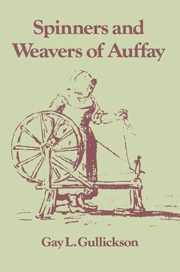 The Spinners and Weavers of Auffay
The Spinners and Weavers of Auffay Book contents
- Frontmatter
- Contents
- Preface
- 1 Introduction
- 2 The pays and the village
- 3 Proto-industrial theory and the pays de Caux
- 4 The golden age of spinning
- 5 Crisis and change in the Caux
- 6 The golden age of cottage weaving
- 7 Marriage and family in proto-industrial Auffay
- 8 Widowhood, remarriage, and the sexual division of labor
- 9 Unwed mothers and their children
- 10 Conclusions: the causes and consequences of proto-industrialization
- Appendix Vital statistics for Auffay
- Notes
- Bibliography
- Index
6 - The golden age of cottage weaving
Published online by Cambridge University Press: 29 October 2009
- Frontmatter
- Contents
- Preface
- 1 Introduction
- 2 The pays and the village
- 3 Proto-industrial theory and the pays de Caux
- 4 The golden age of spinning
- 5 Crisis and change in the Caux
- 6 The golden age of cottage weaving
- 7 Marriage and family in proto-industrial Auffay
- 8 Widowhood, remarriage, and the sexual division of labor
- 9 Unwed mothers and their children
- 10 Conclusions: the causes and consequences of proto-industrialization
- Appendix Vital statistics for Auffay
- Notes
- Bibliography
- Index
Summary
In the nineteenth century, what had been a sexual division of labor between spinning (performed by women) and weaving (performed by men) became a geographical division of labor. Spinning moved from the center of the Caux to its borders, where it concentrated along the tributaries of the Seine. By 1823, there were 121 spinning mills in the Seine-Inférieure. Only ten were on small streams in the interior of the Caux, and most of these would not survive for long. Ninety-five were in the valleys near Rouen, nine were near Le Havre (the entry point of raw cotton), and seven were near Dieppe. The yarn produced in these mills continued to be put out into the villages of the Caux for weaving, however, and much of the cloth produced for the Rouen merchants continued to come from looms set up in the homes of the cauchois peasants. Now, however, both men and women worked at these looms.
The rise of cottage weaving
It is impossible to tell exactly how quickly spinning disappeared as a cottage occupation in Auffay because the recording of female occupations in the civil registers is almost nonexistent for the quarter century between 1803 and 1828. After that period, however, female marriage occupations are recorded more systematically, and it is clear that by the 1830s cottage spinning was dead in Auffay and the other cauchois villages.
- Type
- Chapter
- Information
- The Spinners and Weavers of AuffayRural Industry and the Sexual Division of Labor in a French Village, pp. 108 - 128Publisher: Cambridge University PressPrint publication year: 1986


